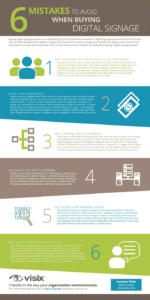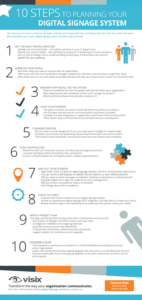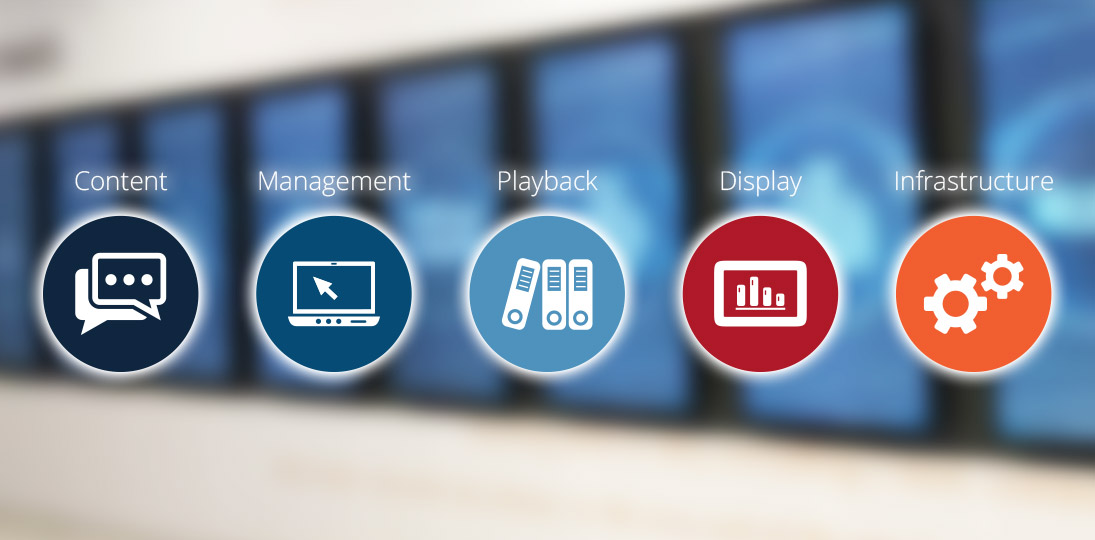Choosing the right digital signage software can feel overwhelming. While you may be the one facilitating the purchase, you’re likely not the person who will interact with the system day-to-day. This presents its own challenges because the users of digital signage systems usually have different priorities than IT teams. People often begin with the hardware and work inwards, but it’s actually better to save many hardware considerations for later in the process.
This comprehensive guide will equip you with the knowledge to make an informed decision. We’ll cover key considerations for IT professionals and end-users alike, from understanding the core components of a digital signage system to avoiding common pitfalls and developing a successful implementation plan.
What is Digital Signage and How Does it Work?
Digital signage utilizes dynamic, real-time content like videos, images, and text to communicate messages effectively. Unlike static signage, it offers flexibility and the ability to update information instantly. A typical digital signage system comprises:
- Displays: LED, LCD, or OLED screens in various sizes and resolutions.
- Media Players: Devices that power the displays and transmit content from the content management system (CMS).
- CMS: Software that controls, schedules, and updates content displayed on the screens.
- Network Connection: Enables remote content updates and management.
From a central location, you can push out new messages across multiple locations instantly, ensuring that all screens are displaying up-to-date information. Some key benefits of digital signage are:
- Enhanced Communication: Effectively convey messages to target audiences.
- Increased Engagement: Capture attention and drive customer interaction.
- Improved Brand Visibility: Increase brand awareness and promote products/services.
- Streamlined Operations: Simplify information dissemination and internal communications.
- Data-Driven Insights: Track audience engagement and measure campaign effectiveness.
Mistakes to Avoid When Purchasing Digital Signage
When considering a digital signage system, it’s essential to avoid common pitfalls that can lead to frustration or unnecessary costs down the line. Here are the top mistakes to keep in mind:
1. Not Defining Clear Objectives
A lack of clear goals can make it difficult to evaluate potential systems and ensure they meet the needs of both your organization and the people who will actually be using the system. Are you using it for marketing, internal communications, or public information? Your goals will determine everything from hardware to content management software.
2. Choosing the Wrong Hardware
Don’t just get the cheapest option available. Buying the wrong display hardware can lead to significant headaches. Consider factors such as screen size, resolution, brightness, and durability. Make sure that the screens are appropriate for the environment. For instance, a brightly lit area may require high-brightness displays, while a more subdued space might only need a standard screen.
3. Underestimating the Complexity of Content Management
You need a content management system (CMS) that is both flexible and easy to use. While it’s crucial that the CMS allows IT teams to efficiently manage the network, it should also offer an intuitive interface for the end users who will be updating and managing the content. Take time to demo the software to ensure it fits your team’s needs and skill level.
4. Neglecting Content Creation Planning
Content is the heart of any digital signage system, but many organizations fail to plan for its ongoing creation. Will the content be created in-house, or will you outsource it? Do you have dedicated people for content production, or will someone have to manage this in addition to other responsibilities? Defining your content strategy early on will save a lot of headaches later and prevent pushing out content that’s stale or just doesn’t work.
5. Overlooking Scalability
While it’s easy to purchase a system that fits your current needs, digital signage systems should be scalable to accommodate future growth. Whether you plan to expand to additional locations, increase the number of screens, or incorporate more complex content, make sure that the system can grow with your business.
6. Forgetting About End-User Training
Even if you select the best digital signage hardware and software, it’s important to train the people who will use the system on a daily basis. Make sure your team is equipped to handle tasks like uploading new content, troubleshooting minor issues, and keeping content up to date. A lack of training can lead to inefficiency, frustration, and missed opportunities.

Key Questions to Ask When Buying Digital Signage
As you prepare to purchase a digital signage system, it’s essential to ask the right questions. These will guide your decision-making and help ensure that you select a system that meets your unique needs.
Some of the critical questions to ask yourself include:
- What are the specific goals for the digital signage system?
- What type of display screens will be used? Do any of them need to be interactive?
- Who will be responsible for managing and updating the content? If you plan to have multiple content contributors, will you need templates and an approval process to control what ultimately gets shown?
Some questions to ask potential vendors:
- Ease of Use: How user-friendly is the CMS for both IT and non-technical users?
- Content Management Features: What content formats are supported? Does it offer scheduling, analytics, and interactive features?
- Scalability and Flexibility: Can the system accommodate future growth in terms of screens, locations, and content complexity?
- Integration Capabilities: Does it integrate with existing systems, like data sources or calendaring systems?
- Support and Maintenance: What level of support is provided? Are there options for remote troubleshooting and maintenance?
- Security: What security measures are in place to protect the system from cyber threats?
- Cost of Ownership: What are the total costs associated with hardware, software, installation, and ongoing maintenance?
These questions will help clarify what you need in terms of functionality, ease of use, support, and cost, ultimately allowing you to make a more informed decision.

10 Steps to Plan Your Digital Signage System
Purchasing a digital signage system is a significant investment, so having a clear plan is vital. Here are the 10 essential steps to follow:
- Define Objectives: Understand why you want a digital signage system and what you hope to achieve. The more specific your goals are, the better.
- Identify Your Audience: Know who will be viewing the content and what will resonate with them.
- Determine Content Needs: What kind of content will you display? Think about video, images, social media, or real-time data.
- Evaluate Your Environment: Consider where the displays will be placed and what factors like lighting or space limitations may affect screen choice.
- Choose the Right Technology: Select the appropriate hardware (screens, media players) and software (CMS).
- Plan for Content Creation: Determine who will create and maintain content, and establish processes for regular updates.
- Ensure Scalability: Choose a system that can grow with your needs, whether you’re adding more screens or increasing the complexity of content.
- Set a Budget: Include all associated costs – hardware, software, installation, and ongoing maintenance.
- Train Your Team: Ensure that both IT staff and content managers understand how to use the system effectively.
- Install and Test: Ensure a smooth installation process, followed by thorough testing to ensure everything works as expected before going live.

Final Thoughts
By carefully considering these factors and following a well-defined implementation plan, you can successfully deploy a digital signage system that meets your specific needs and delivers a strong return on investment. With the right approach, digital signage can be a powerful tool to enhance communication, increase engagement, and help your organization stay ahead of the curve.
